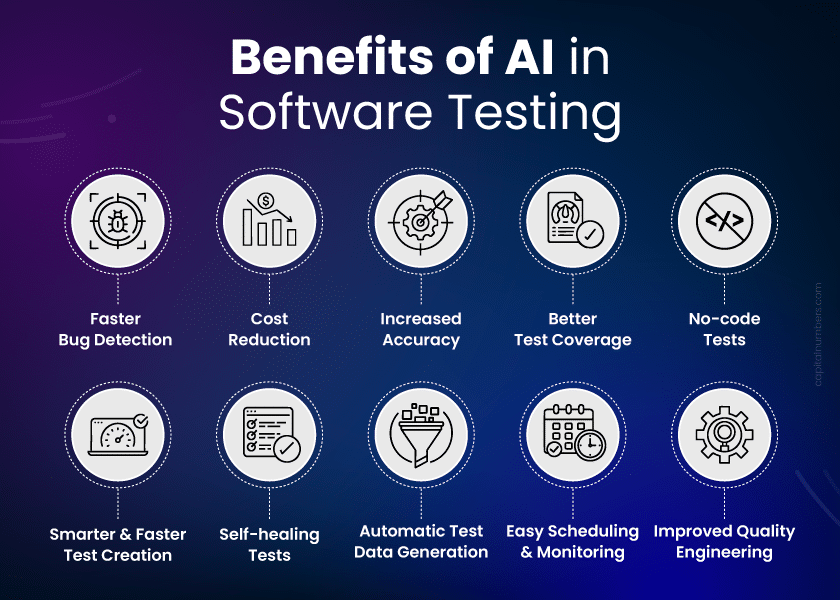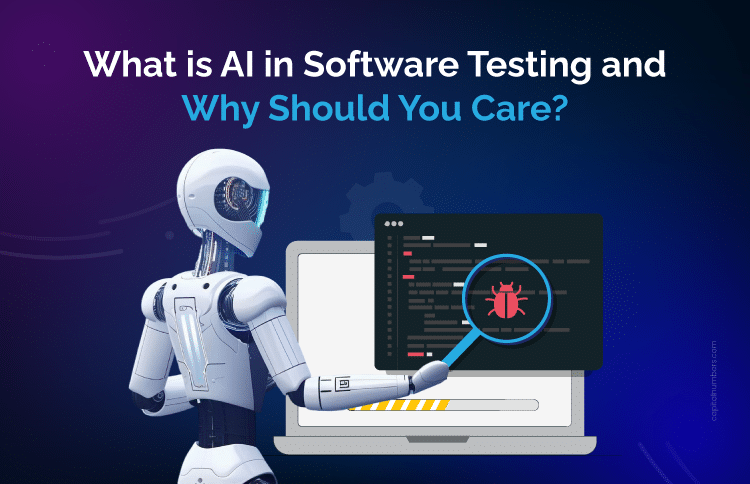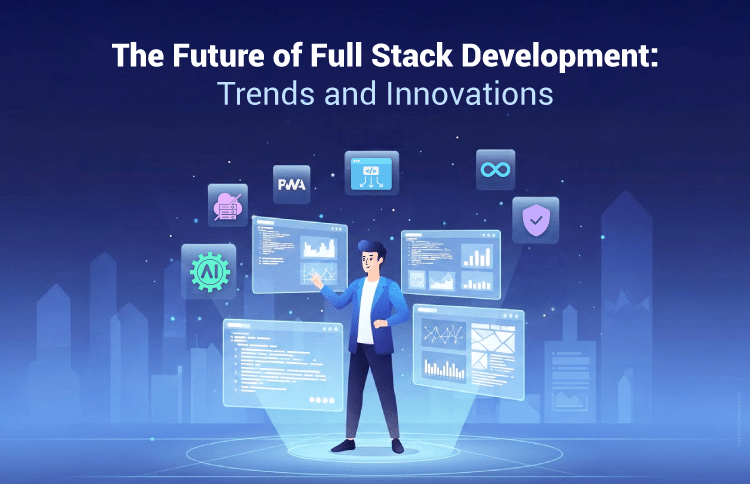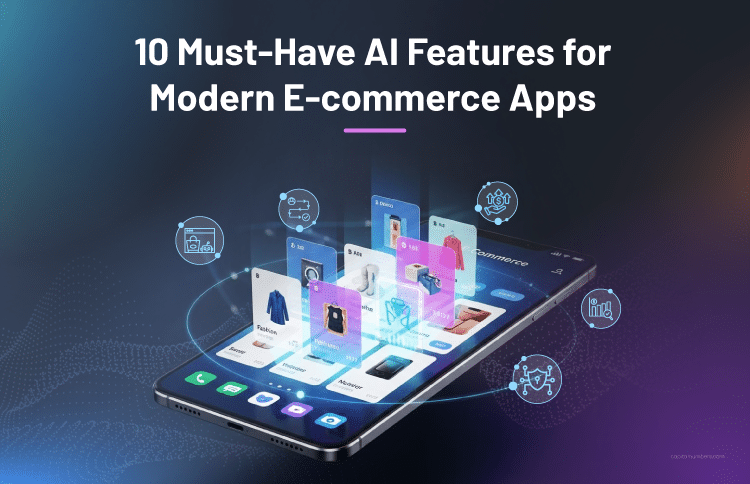What is AI in Software Testing and Why Should You Care?
Table of Contents
AI in software testing uses machine learning, natural language processing, and data analysis to automate testing, improve accuracy, and quickly identify issues. It helps predict potential problems before they happen, reducing manual effort and ensuring better software quality. As AI learns from past test results, it adapts to software changes, making testing more efficient and reliable over time.
Why should you care about AI in software testing? Because it’s becoming a key part of the future of software testing. AI takes care of repetitive tasks, allowing teams to focus on high-value work. It speeds up testing, helps find bugs early, and reduces delays. AI-driven testing also improves software quality, lowers the risk of errors, and cuts maintenance costs after release. This leads to faster launches, better user experiences, and more scalable, reliable products.
Want to learn how AI is changing software testing? Curious about the types of AI testing and the tools that make it possible? Check out our blog for more insights!
Types of AI Testing
There are various types of testing where AI plays a crucial role, each helping improve the efficiency, accuracy, and speed of the testing process. Below are some key types of AI testing that are reshaping the software testing landscape:
1. AI-based Functional Testing
AI-based functional testing takes traditional software testing to the next level by incorporating artificial intelligence to automate repetitive tasks, generate test cases, and enhance test accuracy.
Here are the key aspects of AI-based functional testing:
- Automation: AI automates time-consuming tasks such as generating test cases, executing tests, and validating data, allowing testers to focus on more complex, high-level analysis.
- Test Case Generation: AI can automatically generate test cases based on user behavior, code analysis, or other inputs. This reduces the time and effort traditionally needed for test creation.
- Improved Accuracy: AI-powered testing minimizes human errors and biases, resulting in more reliable and precise test results.
- Defect Detection: AI identifies defects and potential issues faster than manual methods, enabling earlier bug fixes and reducing the risk of issues in production.
- Predictive Analysis: Some AI tools are capable of predicting potential problems before they arise, allowing for proactive resolution and preventing critical issues from escalating.
- AI-to-AI Testing: AI can be used to test other AI-driven systems, such as large language models (LLMs), chatbots, and AI features, ensuring they perform as expected and remain reliable.
2. AI-based Regression Testing
AI-based regression testing uses artificial intelligence to check if new code changes affect existing features automatically. It generates test cases, prioritizes them based on risk, and learns from past tests to improve over time. This makes regression testing faster, more accurate, and more efficient than traditional methods.
Here are the key aspects of AI-based regression testing:
- Automated Test Case Generation: AI automatically creates test cases based on code changes, user behavior, and past data, saving time on manual test creation.
- Prioritization: AI helps identify and focus on the most important test cases, ensuring key features are tested first.
- Intelligent Analysis: AI predicts which parts of the software are likely to be impacted by new changes, directing testing to the most critical areas.
- Continuous Learning: AI learns from past test results and adjusts the test process, improving over time and optimizing test execution.
- Early Defect Detection: AI finds issues early in the development cycle, reducing the risk of new bugs and saving time in the long run.
- Reduced Manual Effort: AI automates many repetitive tasks, freeing up testers to focus on more complex problems.
- Improved Test Coverage: AI ensures that more important areas of the application are thoroughly tested, reducing the chance of missing issues.
- Enhanced Accuracy: AI can identify subtle bugs that might be missed by manual testing, helping ensure higher-quality software.
3. AI-based Performance Testing
AI-based performance testing uses artificial intelligence, especially machine learning, to make the testing faster and more efficient. Unlike traditional performance testing, AI analyzes large amounts of data, predicts potential issues, and adjusts test scenarios in real-time, improving overall testing accuracy and speed.
Here are the key aspects of AI-based performance testing:
- Automated Test Generation: AI analyzes application behavior and automatically generates test scripts, saving time on manual test creation.
- Anomaly Detection: AI tracks performance metrics in real-time, spotting deviations from expected behavior and identifying potential problems.
- Predictive Performance Analytics: By reviewing historical data, AI predicts performance bottlenecks and scalability issues before they occur.
- Root Cause Analysis: AI quickly identifies the causes of performance issues, helping resolve problems faster.
- Adaptive Testing: AI adjusts test scenarios in real-time based on performance feedback, ensuring more accurate results.
- Data Analysis and Prediction: AI processes large data sets to spot patterns and trends, predicting issues ahead of time.
- Democratizing Testing: AI makes performance testing easier to run and understand, even for users with less technical experience.
4. AI-based Security Testing
AI-based security testing uses artificial intelligence to help find vulnerabilities and security risks in software applications. By using machine learning, AI can analyze code, track how the application behaves, and simulate attacks to spot weaknesses that traditional methods might miss.
Here are the key aspects of AI-driven security testing:
- Automated Vulnerability Detection: AI scans applications and code for known and unknown security threats, such as SQL injection or cross-site scripting (XSS), identifying risks automatically and reducing manual effort.
- Simulating Attacks: AI simulates cyberattacks on the application, testing its ability to withstand real-world threats and uncovering vulnerabilities in the security system.
- Predictive Security Analytics: By analyzing past attack data, AI predicts where new vulnerabilities may arise, helping teams proactively address potential risks before they happen.
- Behavioral Analysis: AI monitors the behavior of applications to spot unusual activity or patterns that might indicate a security breach, enabling faster threat detection.
- Continuous Learning: AI continuously learns from emerging threats and updates its algorithms, adapting to new attack methods and improving the overall security testing process.
- Faster Risk Mitigation: AI helps to identify risks early in the software development cycle, reducing the chances of security breaches by addressing issues before they are exploited.
- Specialized AI Penetration Testing: AI penetration testing focuses on finding vulnerabilities in AI-driven systems, such as applications and machine learning models. This type of testing ensures that AI systems are secure and not vulnerable to manipulation or exploitation.
5. AI-based Usability Testing
AI-based usability testing uses artificial intelligence to automate and improve the process of evaluating how easily users can interact with a product or system. It automates tasks like analyzing data, spotting patterns in user behavior, and predicting potential usability issues. By doing so, AI provides designers and developers with deeper insights into user interactions, helping them make better design decisions.
Here are the key aspects of AI-based usability testing:
- Automated Data Analysis: AI analyzes large amounts of user data quickly, identifying patterns and insights that would be difficult to spot manually.
- Behavior Pattern Recognition: AI can track and analyze how users interact with an application, detecting usability issues like navigation problems or confusing interfaces.
- Predictive Issue Detection: AI can predict potential usability problems before they occur, helping teams address issues early in the design process.
- Continuous Learning: AI continuously learns from user interactions and adapts to improve its ability to spot issues, providing ongoing insights as the product evolves.
- User Feedback Simulation: AI simulates user behavior to identify friction points and areas where users may struggle, ensuring a smoother user experience.
- Enhanced User Experience Insights: AI provides detailed insights into how users engage with the system, helping teams make more informed design decisions to improve the overall user experience.
6. AI-based Ethical and Compliance Testing
AI-based ethical and compliance testing uses artificial intelligence to ensure that software follows legal, ethical, and regulatory standards. AI automates checks for compliance with data privacy laws, identifies biases in algorithms, and ensures the application follows ethical guidelines, helping companies avoid legal issues and protect user data.
Here are the key aspects of AI-based ethical and compliance testing:
- Identifying and Mitigating Bias: AI detects and addresses algorithmic biases that could lead to unfair or discriminatory outcomes, ensuring the system works impartially.
- Ensuring Fairness and Accountability: AI testing ensures that systems are fair and accountable, especially in critical areas like hiring, lending, and criminal justice.
- Adhering to Ethical Principles: AI-based testing frameworks evaluate systems based on ethical principles like fairness, transparency, accountability, and privacy.
- Compliance with Regulations: AI testing helps organizations meet legal and regulatory requirements, particularly those related to data privacy and consumer protection laws.
- Monitoring and Evaluation: AI continuously monitors and assesses the ethical performance of AI systems throughout their lifecycle to ensure ongoing compliance.
- Automated Testing and Analysis: AI automates tasks such as data validation, test execution, and error detection, improving both the speed and accuracy of compliance testing.
- Explainability and Transparency: AI-based testing ensures that AI systems are explainable and transparent, helping users and stakeholders understand how decisions are made and why they occur.
Ready to take your software testing to the next level? Get a comprehensive range of software testing services to improve efficiency, enhance accuracy, and ensure faster, high-quality software releases
What Are the Benefits of AI in Software Testing?

AI in software testing brings many advantages, making the process faster, more accurate, and more cost-effective. Here’s how AI helps improve the software testing process:
- Faster Bug Detection
AI tools can detect bugs much faster than manual testing. By scanning large amounts of code quickly, AI in software testing helps find issues early, ensuring they are fixed before they impact users. - Cost Reduction
With AI in software testing, businesses reduce the need for extensive manual labor, saving time and money. Automated testing is more efficient, helping companies minimize testing costs while maintaining quality. - Better Test Coverage
AI ensures more thorough testing by checking all parts of the application. It runs through different scenarios and checks various test cases, making sure nothing is missed and improving the quality engineering process. - Increased Accuracy
Unlike humans, AI doesn’t make errors due to fatigue or biases. AI-powered tests are more accurate, reducing the chance of false positives or false negatives and ensuring that your software is reliable. - Continuous Testing
AI allows for continuous testing, meaning that tests can run constantly throughout the software development life cycle. This ensures issues are caught early, and testing continues without slowing down development. - No-code Tests
Testers can automate tests easily using visual models like record-and-playback or drag-and-drop, which eliminates the need for complex coding and allows non-technical users to participate in the testing process. - Smarter and Faster Test Creation
AI enables testers to create tests quickly by performing actions on screen, making the test creation process faster and more intuitive. - Self-healing Tests
AI automatically updates test scripts to adapt to minor application changes, reducing the need for manual updates and maintenance. - Automatic Test Data Generation
AI automatically generates and maintains test data, reducing the effort involved in creating test data and ensuring consistency. - Easy Scheduling and Monitoring
AI automates the scheduling, maintenance, and monitoring of tests, making it easier to integrate with CI systems and saving time and resources. - Improved Quality Engineering
AI learns from past tests and continuously improves, making testing smarter and more effective as the software evolves.
You May Also Read: Behavior-Driven Development: Bridging the Gap Between Development and Testing
AI Software Testing vs. Manual Software Testing
Software testing has changed a lot with the introduction of artificial intelligence (AI). In the past, manual testing was the main method used to check if software worked correctly. Testers would run tests, find bugs, and make sure the software met the necessary standards. But as software has become more complex and the need for faster releases has grown, AI-driven testing has become a popular option. Unlike manual testing, which takes a lot of time and can have human errors, AI testing uses machine learning, data analysis, and automation to make the process faster, more accurate, and more efficient.
Let’s break down the key differences between these two methods.
I. Speed of Testing
- Manual Testing: Manual testers follow detailed test cases step by step, making it a slower process. As the application grows, so does the time to test it manually.
- AI Software Testing: AI can execute thousands of tests at once, speeding up the process. This improves test efficiency with AI, allowing for faster feedback, quicker releases, and a more agile development process.
II. Accuracy and Consistency
- Manual Testing: While human testers are essential for detecting certain bugs, they are prone to errors, especially with repetitive tasks. Fatigue can lead to missed issues or inconsistent test execution.
- AI Software Testing: AI doesn’t suffer from fatigue, ensuring consistent and accurate testing every time. With AI, there’s a reduced chance of human error, making it easier to identify complex bugs and improve software quality.
III. Cost-Effectiveness
- Manual Testing: As projects scale, the costs of hiring large testing teams increase. Manual testing often involves long hours, which adds to overall expenses.
- AI Software Testing: By automating many testing tasks, AI helps reduce the need for a large manual team. This leads to reducing testing costs with AI. With fewer resources required, businesses can allocate their budgets more efficiently, keeping costs low while maintaining high-quality testing.
IV. Test Coverage
- Manual Testing: Human testers can only cover a limited number of scenarios within a set time frame. Certain edge cases or complex scenarios may go unchecked.
- AI Software Testing: AI can easily run tests on a wide range of scenarios, improving coverage and ensuring that no aspect of the software is overlooked. With improved test efficiency with AI, every part of the application can be tested thoroughly.
V. Human Involvement
- Manual Testing: Requires extensive human involvement for planning, execution, and analysis of results. Testers must constantly adjust to changes in the software or test cases.
- AI Software Testing: Once implemented, AI requires much less human intervention. While human oversight is still needed, AI in QA helps reduce the workload, allowing the team to focus on more complex issues, leading to increased productivity.
VI. Adaptability
- Manual Testing: As the software evolves, so do the testing requirements. Test cases must be manually updated, which can be time-consuming.
- AI Software Testing: AI can quickly adapt to changes in the software, learning from past tests to improve future test strategies. It involves continuous improvement and faster adaptation to new features or updates.
VII. Scalability
- Manual Testing: Scaling manual testing requires more testers and resources. As the project expands, the testing process becomes harder to manage effectively.
- Software Testing: AI scales effortlessly. Whether the project is small or large, AI can handle the increased testing load without requiring extra personnel. This scalability makes AI a perfect fit for businesses looking to grow without increasing their testing costs.
While manual testing remains essential for certain use cases, AI software testing provides significant advantages in speed, accuracy, cost-effectiveness, and scalability, making it the ideal choice for modern, large-scale applications.
You May Also Read: Elevating Software Quality Through Black Box Testing
AI Testing Tools
AI testing tools are becoming important in software development because they automate tasks, improve accuracy, and speed up the testing process. These tools use machine learning to predict results, find bugs, and reduce manual work. Here are some popular AI testing tools that are changing the way we test software.
Test.ai
Test.ai is an AI-powered tool that automates functional testing, primarily for mobile and web applications. It uses machine learning to understand how users interact with the UI and creates tests based on those actions. The tool learns from past tests and adapts to new features, making it easier to keep tests up-to-date.
Key Features:
- Visual test automation
- Cross-platform testing (mobile/web)
- Self-healing tests (AI adapts to UI changes)
Applitools Eyes
Applitools Eyes is a visual testing tool that uses AI to ensure your app looks the same on different devices and browsers. It automatically compares screenshots to spot visual differences, making it ideal for apps where design consistency is crucial.
Key Features:
- AI-powered visual comparisons
- Cross-browser and mobile testing
- Detects visual bugs using AI
Functionize
Functionize is an AI-based platform that uses natural language processing (NLP) to help you write tests in plain English. The tool automatically adapts tests as the software changes, so you don’t have to rewrite them each time there’s an update.
Key Features:
- No-code test creation using plain English
- Self-healing tests
- Scalable automation for web and mobile
TestComplete
TestComplete is a test automation tool that uses AI to generate and run tests across web, desktop, and mobile applications. It adapts to changes in the app, making it easier to identify and fix bugs during development.
Key Features:
- AI-driven test generation
- Support for multiple platforms (web, mobile, desktop)
- Integration with CI/CD tools
Mabl
Mabl is an AI-powered tool that automates functional testing. It can adapt to changes in the app’s UI and automatically adjust tests. Mabl integrates seamlessly with continuous integration (CI/CD) pipelines, helping automate testing during development.
Key Features:
- AI-powered automated testing
- Automatic test maintenance
- Works well with CI/CD systems
Sahi Pro
Sahi Pro is another AI-based tool for functional and regression testing of web apps. It uses AI to create self-healing tests that adjust as the application evolves. It supports multiple browsers and testing technologies.
Key Features:
- Self-healing tests powered by AI
- Cross-browser testing
- Functional and regression testing
AI testing tools are changing how we test software by automating tasks and improving accuracy. These tools help companies deliver better software faster and more efficiently.
Challenges of Implementing AI in Software Testing
AI is changing the way we do software testing, but implementing AI tools comes with several challenges. Here are some key issues organizations face when adopting AI in testing:
Data Quality and Availability
AI relies on good data to work properly. If the data is incomplete, biased, or inaccurate, the results will be unreliable. Ensuring high-quality data is crucial for AI to give accurate test results and improve the testing process.
Lack of Expertise
Using AI in software testing requires knowledge of both AI and traditional testing. Many companies struggle to find skilled professionals who can handle both areas, slowing down the adoption of AI-powered tools and delaying progress in test automation.
Integration with Existing Tools
Companies already have established testing systems, and integrating AI with these tools can be difficult. AI testing tools must work well with other systems, such as CI/CD pipelines and version control tools. Poor integration can reduce AI’s effectiveness in improving test efficiency.
Initial Setup and Training
Setting up AI testing tools takes time and resources. These tools need to be trained for specific applications, and AI models need regular updates. The process can be time-consuming, especially for companies new to AI-driven testing.
Cost of Implementation
AI testing tools can be expensive, especially for smaller businesses. The cost of AI tools, infrastructure, and hardware can be high, making it difficult for some companies to justify the investment. Balancing upfront costs with long-term benefits is an important consideration.
Maintaining and Updating AI Models
AI models must be updated as software changes. Regular maintenance is needed to ensure AI continues to perform well. If AI models aren’t kept up-to-date, they may give inaccurate results, which can hurt the overall testing process.
Understanding AI Test Results
AI testing tools generate complex data that can be hard to interpret. Unlike traditional testing, AI results may require deeper analysis to make sense of. Teams need to understand how AI works to interpret the results correctly and avoid missing opportunities to reduce costs and improve quality.
AI in software testing has the potential to improve efficiency and cut costs, but it also comes with challenges like data quality, integration, and the need for skilled professionals. By overcoming these hurdles, businesses can benefit from AI-powered test automation and improve their QA processes.
Will AI Replace Manual Testers?
No, AI will not replace manual testers, but it will enhance their roles by:
- Automating repetitive tasks, saving time and increasing efficiency
- Quickly identifying test gaps to improve test coverage
- Allowing testers to focus on more complex areas like exploratory, usability, and security testing
- Using their strong domain knowledge to test AI-driven systems, such as large language models (LLMs) and chatbots
In essence, AI will work alongside testers, boosting their capabilities while they focus on high-level testing and domain-specific challenges.
You May Also Read: Complete Guide to API Testing: Methods and Best Practices
Final Words
In conclusion, AI is changing how we test software by automating tasks, improving accuracy, and speeding up the process. It helps identify potential issues early, which leads to faster bug detection and better test coverage. At the same time, it reduces costs and manual work. This technology allows businesses to release better software more quickly, leading to better customer experiences. As AI continues to improve, it will play an even bigger role in software testing, offering even more advanced features.















